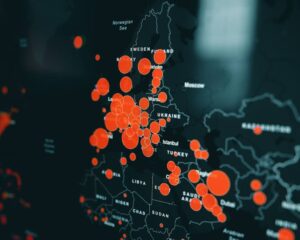School reports, proposal presentations, office meetings, or teaching students — whatever it is you’re doing that involves numbers and big amounts of data, visual representation can make your job easier. For many years, we have been using it to make our data perceivable in the eyes of our audience. It helps us give a clear idea of what information means by visual context.
The creativity and effort it takes to come up with a general and effective way to display informative data is tiring. Fortunately, there are graph makers like Venngage that can help you make your presentations vividly and communicatively.

Campaign creators/Unsplash
What is a visual representation and why is it important?
Visual presentation is an effective and fast-paced method to convey figures and statistical data in a comprehensible manner. It makes information easily accessible by feeding into your audience’s natural tendency to learn by seeing and interacting.
It uses visual data to aid companies in identifying which areas need improvement or in comparing the company’s sales from the last six months. This practice represents numbers in a study, provides shape, pattern, and a brief comparison of data which is crucial in analysis and decision making.
Without a visual representation of data and knowledge, identifying the correlations between the relationship of an independent variable will be challenging.
Who uses visual representation?
With today’s technology, people are inclined to use an easier way to complete tasks. With the help of desktops, laptops, and smartphones, we can easily gather data and digitalize reports.
That’s why almost everyone uses visual representation. Students, employees, and big companies all benefit from it. It’s universal, fast, and efficient in conveying data and knowledge.
Types of Visual Representations

Ruthson Zimmerman/ Unsplash
Visual representation comes in different forms and shapes that help us organize and understand data in a much simpler way. Venngage also offers a wide range of ready-to-use templates for such projects. It lets you choose from a simple line graph to much more complex and detailed presentations.
To give you an idea, here are some examples:
Graphs and Charts

Isaac Smith/ Unsplash
Graphs and charts compress a large quantity of information into a comprehensible format that clearly and effectively communicates important elements.
To present your data effectively, you need to know the purpose of your graph/chart and what you want to present. Check and filter what you want to include and whether they should be expressed as frequencies or categories.
Graphs and charts have many different types, familiarizing them makes it easier for a business to choose the one that fits their need most.
Maps

Clay Banks/ Unsplash
You can use a map to clearly illustrate gathered demographic illustrations like age, ethnicity, race, gender, and marital status. This type of representation is best used in plotting population data and surveys.
Data relatable illustrations
Using relatable icons or symbols for your data report could also help convey your message to your audience. It also adds life and color to your presentations making your report comprehensible and at the same time pleasing to the eye.
Tree diagram
A tree diagram represents variables that are in sequence or an independent event or condition relating to possible actions. It is also best used in organizing a hierarchy of systems.
How to use visual representation effectively?
Behind every effective visual representation is a hardworking person who puts his ideas and plans into action. Here are some quick tips to help you create a successful visual presentation:
Gather all the needed data
Gathering all the needed data for your report is a crucial step in making a successful presentation. Incomplete data would highly reflect on your visual presentation’s outcome. Always remember that every variable is important in statistical reports.
Organize all data
After gathering all the important data for your presentation, review them one by one and match them according to their relatability. You can pair up each data or group them to make the next step easier.
Analyze
After organizing your data, analyze what type of data visualization would best suit your report. Choosing the right format would increase your visual representation’s success.
Be creative and fun
Do not forget to add colors to your presentation. Reports can sometimes become too dragging and one way to spice it up is to make your presentation visually enticing.
It sets a light and fun mood that can make presentations and/or learning exciting and easy.
Using visual representation is easy and is a sure way to present your variables effectively. All you have to do is consider your resources and make sure that you have all the essential tools in crafting your visuals. Graph maker platforms can also be of big help if you’re confused about which template would best fit your data.
Now that you’ve had all the information you need in making data presentations, you can now start and make one today!
